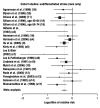Exercise as stroke prophylaxis
- PMID: 19997550
- PMCID: PMC2788906
- DOI: 10.3238/arztbl.2009.0715
Exercise as stroke prophylaxis
Abstract
Background: Stroke is the third most common cause of death in industrialized countries, accounting for more than 10% of deaths over age 65. Most strokes are due to arteriosclerosis. Regular physical activity lowers arterial blood pressure and body weight and improves glucose and lipid metabolism, thereby slowing the development of arteriosclerosis and its cardiovascular complications, particularly myocardial infarction. This review focuses on the question whether physical activity might also have a preventive effect on cerebral infarction and hemorrhage.
Methods: This analysis is based on 33 prospective cohort studies and 10 case-control studies that addressed the potential effect of physical activity on stroke-related morbidity and mortality.
Results: Our meta-analysis shows that physical activity reduces the risk of all types of stroke (infarction, hemorrhage, and stroke of unspecified type). The relative risk (RR) of fatal or non-fatal cerebral infarction is 0.75, while the corresponding figures for cerebral hemorrhage and stroke of unspecified type are 0.67 and 0.71, respectively. The reduction of risk is only statistically significant for men. The case-control studies show an RR of 0.32 for men and women combined.
Conclusions: When a multivariate analysis is performed that takes other vascular risk factors into account, physical activity is found to have an independent protective effect against cerebrovascular events. The effect is statistically significant only for men, not for women.
Keywords: cerebral hemorrhage; health-related behavior; physical activity; risk of stroke; stroke.
Figures
Similar articles
-
Physical activity in the prevention and treatment of colorectal carcinoma.Dtsch Arztebl Int. 2009 Oct;106(44):722-7. doi: 10.3238/arztebl.2009.0722. Epub 2009 Oct 30. Dtsch Arztebl Int. 2009. PMID: 19997551 Free PMC article. Review.
-
Physical activity and stroke risk: a meta-analysis.Stroke. 2003 Oct;34(10):2475-81. doi: 10.1161/01.STR.0000091843.02517.9D. Epub 2003 Sep 18. Stroke. 2003. PMID: 14500932
-
Risk-factor profile for the incidence of subarachnoid and intracerebral haemorrhage, cerebral infarction, and unspecified stroke during 21 years' follow-up in men.Scand J Public Health. 2006;34(6):589-97. doi: 10.1080/14034940600731523. Scand J Public Health. 2006. PMID: 17132592
-
[The reduction of stroke risk, risk of myocardial infarction and death by healthy diet and physical activity].Bull Soc Sci Med Grand Duche Luxemb. 2013;(2):51-62. Bull Soc Sci Med Grand Duche Luxemb. 2013. PMID: 24437075 German.
-
Hormone replacement therapy and stroke.Curr Vasc Pharmacol. 2008 Apr;6(2):112-23. doi: 10.2174/157016108783955338. Curr Vasc Pharmacol. 2008. PMID: 18393913 Review.
Cited by
-
Premorbid physical activity is modestly associated with gait independence after a stroke: an exploratory study.Eur Rev Aging Phys Act. 2018 Dec 26;15:18. doi: 10.1186/s11556-018-0208-8. eCollection 2018. Eur Rev Aging Phys Act. 2018. PMID: 30603050 Free PMC article.
-
Lack of exercise is a major cause of chronic diseases.Compr Physiol. 2012 Apr;2(2):1143-211. doi: 10.1002/cphy.c110025. Compr Physiol. 2012. PMID: 23798298 Free PMC article. Review.
-
[Heart and sports].Herz. 2012 Aug;37(5):471-3. doi: 10.1007/s00059-012-3633-x. Herz. 2012. PMID: 22689154 German. No abstract available.
-
A partially supervised physical activity program for adult and adolescent survivors of childhood cancer (SURfit): study design of a randomized controlled trial [NCT02730767].BMC Cancer. 2017 Dec 5;17(1):822. doi: 10.1186/s12885-017-3801-8. BMC Cancer. 2017. PMID: 29207962 Free PMC article.
-
The bidirectional relationship between AMPK pathway activation and myokine secretion in skeletal muscle: How it affects energy metabolism.Front Physiol. 2022 Nov 21;13:1040809. doi: 10.3389/fphys.2022.1040809. eCollection 2022. Front Physiol. 2022. PMID: 36479347 Free PMC article. Review.
References
-
- Endres M, Gertz K, Lindauer U, et al. Mechanisms of stroke protection by physical activity. Ann Neurol. 2003;54:582–590. - PubMed
-
- Vinereanu D. Risk factors for atherosclerotic disease: present and future. Herz. 2006;(31 Suppl. III):5–24. - PubMed
-
- Lee CD, Folsom AR, Blair SN. Physical activity and stroke risk. A meta-analysis. Stroke. 2003;34:2475–2482. - PubMed
-
- Goldstein LB, Adams R, Alberts MJ, et al. Primary prevention of ischemic stroke. A guideline from the American Heart Associa-tion/American Stroke Association Council: Cosponsored by the Artherosclerotic Peripheral Vascular Disease Interdisciplinary Working Group; Cardiovascular Nursing Council; Clinical Car-di–ol-ogy Council; Nutrition, Physical Activity, and Metabolism Council; and the Quality of Care and Outcomes Research Inter-disciplinary Working Group. Stroke. 2006;37:1583–1633. - PubMed
-
- Chrysohoou C, Pitsavos C, Kokkinos P, Panagiotakos DB, Singh SN, Stefanadis C. The role of physical activity in the prevention of stroke. Cent Eur J Publ Health. 2005;13:132–136. - PubMed
Publication types
MeSH terms
LinkOut - more resources
Full Text Sources
Medical






